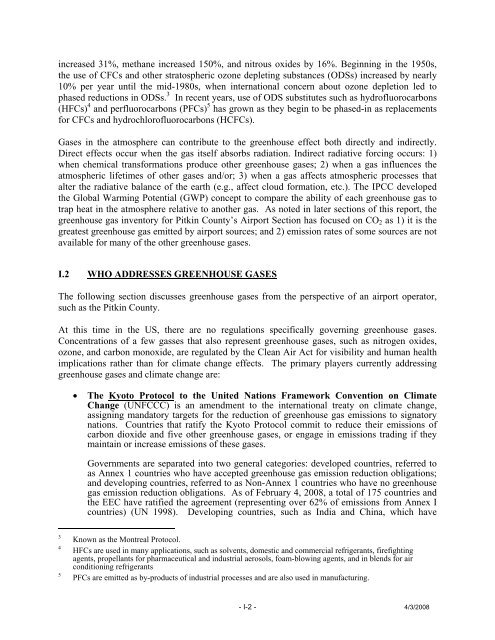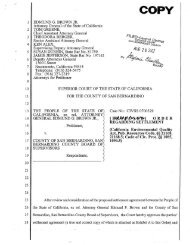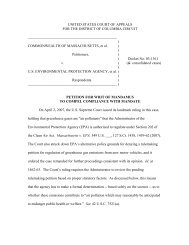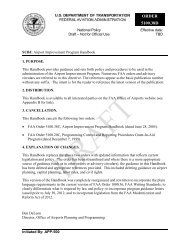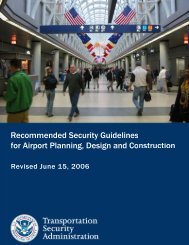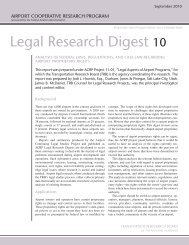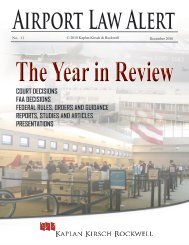Aspen-Pitkin County Airport Greenhouse Gas Emissions Inventory ...
Aspen-Pitkin County Airport Greenhouse Gas Emissions Inventory ...
Aspen-Pitkin County Airport Greenhouse Gas Emissions Inventory ...
You also want an ePaper? Increase the reach of your titles
YUMPU automatically turns print PDFs into web optimized ePapers that Google loves.
increased 31%, methane increased 150%, and nitrous oxides by 16%. Beginning in the 1950s,the use of CFCs and other stratospheric ozone depleting substances (ODSs) increased by nearly10% per year until the mid-1980s, when international concern about ozone depletion led tophased reductions in ODSs. 3 In recent years, use of ODS substitutes such as hydrofluorocarbons(HFCs) 4 and perfluorocarbons (PFCs) 5 has grown as they begin to be phased-in as replacementsfor CFCs and hydrochlorofluorocarbons (HCFCs).<strong>Gas</strong>es in the atmosphere can contribute to the greenhouse effect both directly and indirectly.Direct effects occur when the gas itself absorbs radiation. Indirect radiative forcing occurs: 1)when chemical transformations produce other greenhouse gases; 2) when a gas influences theatmospheric lifetimes of other gases and/or; 3) when a gas affects atmospheric processes thatalter the radiative balance of the earth (e.g., affect cloud formation, etc.). The IPCC developedthe Global Warming Potential (GWP) concept to compare the ability of each greenhouse gas totrap heat in the atmosphere relative to another gas. As noted in later sections of this report, thegreenhouse gas inventory for <strong>Pitkin</strong> <strong>County</strong>’s <strong>Airport</strong> Section has focused on CO 2 as 1) it is thegreatest greenhouse gas emitted by airport sources; and 2) emission rates of some sources are notavailable for many of the other greenhouse gases.I.2 WHO ADDRESSES GREENHOUSE GASESThe following section discusses greenhouse gases from the perspective of an airport operator,such as the <strong>Pitkin</strong> <strong>County</strong>.At this time in the US, there are no regulations specifically governing greenhouse gases.Concentrations of a few gasses that also represent greenhouse gases, such as nitrogen oxides,ozone, and carbon monoxide, are regulated by the Clean Air Act for visibility and human healthimplications rather than for climate change effects. The primary players currently addressinggreenhouse gases and climate change are:• The Kyoto Protocol to the United Nations Framework Convention on ClimateChange (UNFCCC) is an amendment to the international treaty on climate change,assigning mandatory targets for the reduction of greenhouse gas emissions to signatorynations. Countries that ratify the Kyoto Protocol commit to reduce their emissions ofcarbon dioxide and five other greenhouse gases, or engage in emissions trading if theymaintain or increase emissions of these gases.Governments are separated into two general categories: developed countries, referred toas Annex 1 countries who have accepted greenhouse gas emission reduction obligations;and developing countries, referred to as Non-Annex 1 countries who have no greenhousegas emission reduction obligations. As of February 4, 2008, a total of 175 countries andthe EEC have ratified the agreement (representing over 62% of emissions from Annex Icountries) (UN 1998). Developing countries, such as India and China, which have345Known as the Montreal Protocol.HFCs are used in many applications, such as solvents, domestic and commercial refrigerants, firefightingagents, propellants for pharmaceutical and industrial aerosols, foam-blowing agents, and in blends for airconditioning refrigerantsPFCs are emitted as by-products of industrial processes and are also used in manufacturing.- I-2 - 4/3/2008


